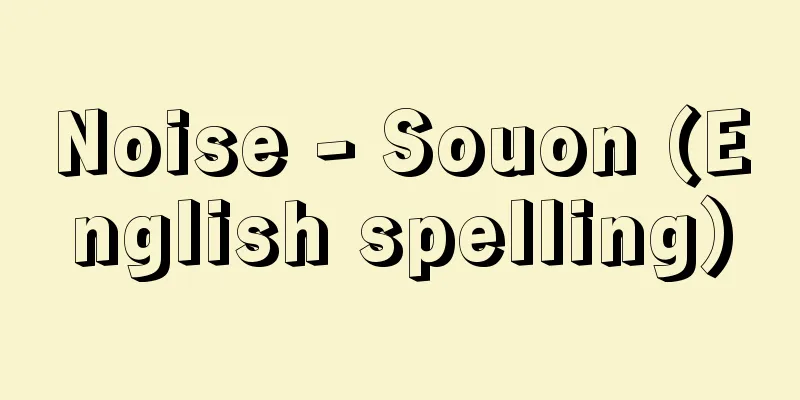Noise - Souon (English spelling)

|
Generally, noise is any sound that is unpleasant to humans. This definition is quite subjective, and a sound that one person finds pleasant may be perceived as noise by another. However, due to recent increases in urban population, overcrowding of transportation, and an increase in construction work, there has been an increase in sounds that most people find to be noise, which has become a major social problem and requires measures to be taken. [Yoshio Hiki] Noise measurementNoise loudness is measured by a sound level meter, which detects noise with a microphone and displays the loudness level on an indicator. Since the sensitivity of human hearing varies depending on the frequency of the sound, the noise is passed through a hearing weighting circuit with similar characteristics to obtain a loudness that is closer to human perception. Standards for the characteristics of hearing weighting circuits are set internationally, and the noise measured with this is called the sound level, measured in decibels (dB). [Yoshio Hiki] Noise controlThere are various efforts to reduce noise, such as reducing the noise generated from the noise source itself, or blocking the propagation of noise by installing a barrier between the noise source and humans. In any case, there is no general method, and each noise source must be studied separately. Also, even with the same sound source, the loudness of the noise varies depending on weather conditions and the time of day. [Yoshio Hiki] Impact of noiseIt is extremely difficult to clarify the impact of noise on human life, but for convenience it can be broadly categorized into physiological impacts, impacts on daily life, and social impacts. The most obvious physiological effect is on hearing. Exposure to high levels of noise can cause temporary hearing loss, and in severe cases, permanent hearing loss. Acceptable standards have been established for the protection of hearing for people who work in noisy work environments for long periods of time. There are also reports of an increase in young people with "hearing disorders," which are not so-called "noise"-related, but are thought to be due to enjoying music and other things with headphones or earphones. Research has shown that noise can cause temporary or permanent damage not only to hearing, but also to all physiological functions, including the digestive, respiratory, circulatory, and nervous systems. In everyday life, interference with the transmission of acoustic information can cause psychological discomfort, reduce work efficiency by preventing concentration, and disrupt rest and sleep. From a social perspective, land use is restricted along major roads and around airports where noise is intense, causing problems such as a fall in land prices and an impact on livestock, resulting in a decline in milk and egg production. Nowadays, even in projects of a public nature, such as road construction or railway construction, noise issues cannot be avoided, and in many cases it is mandatory to investigate the impact in advance and consider countermeasures (see the "Environmental Assessment" section). [Yoshihiro Furue] Ear sensitivity and noise levelIt is said that the human ear can hear sounds with frequencies between approximately 20 Hertz (Hz) and 20,000 Hertz, but this sensitivity also differs depending on the loudness or frequency of the sound. A curve that shows the loudness of a sound based on a 1000 Hertz sound that sounds the same loudness is called an equal sensitivity curve. This is the average of measurements taken by many people, and can be thought of as the average sensitivity of the human ear. It is shown that the lower the frequency of a sound, the harder it is to hear, with sounds between 2000 and 4000 Hertz being the easiest to hear, and sounds of even higher frequencies becoming harder to hear again ( ). Generally, noise contains sounds of various frequencies at various loudnesses simultaneously, and the way it is heard is complicated, but the quantity known as "noise level" (unit: decibel, dB) was devised to express that loudness in a single number. 0 decibels is a sound that is just loud enough to be heard, and for example, the noise level in a busy downtown area during the day is about 80 decibels. When the noise level exceeds 130 decibels, it becomes painful to the ears rather than being loud. [Yoshihiro Furue] Acceptable noise levelNoise is judged subjectively by the person who hears it, but since it is impossible to make no noise at all in social life, it is necessary to have a guideline for what level of noise is acceptable. Naturally, this acceptable noise level differs depending on the time, place, and situation. In other words, the acceptable noise level when sleeping should be low, while it would be okay to let it be a little higher while eating. From this perspective, examples of acceptable noise levels for various indoor locations are shown in . All sounds other than the sounds you want to hear or focus on are called "background noise." For example, the sound of a television you hear when you are enjoying a conversation, or the voices of others you hear when watching television. The acceptable noise level is the "background noise level" that is permitted. From the viewpoint of transmitting information, the lower the background noise level, the better, but if it is too low, it can sometimes cause a psychological feeling of oppression or make people feel uneasy. For this reason, music at an appropriate volume can be used to increase the background noise level (background music, BGM). [Yoshihiro Furue] Building sound insulation planConventional soundproofing plans assume a standard level of noise that comes from outside or from adjacent rooms, and then use materials or structures such as windows and walls to reduce that level to below the acceptable noise level. However, there is a considerable gap in the level of quiet required by individuals living in the building. For example, there is a 40 decibel difference in quietness required between someone who is very sensitive to sound and someone who is completely indifferent. There are also musicians and stereophiles who want the sound level in their rooms to be 80 decibels or higher, while there are also people who live in environments where the sound level is 50 decibels or less. This can lead to unexpected problems, especially in apartments and other collective housing. Taking into account this diversity of residents, planning methods are recommended that make it possible to clearly state in advance the "soundproofing grade," for example, that the specifications are such that "people can live comfortably without having to worry about their neighbors" or "there will be no problems if everyone is careful." [Yoshihiro Furue] "Handbook of Noise and Vibration Control Countermeasures" edited by the Japan Acoustic Materials Association (1982, Gihodo Publishing)" ▽ "Sound Environment Design of Architecture" edited by the Architectural Institute of Japan (1983, Shokokusha)" ▽ "Noise Control Countermeasures for Building Facilities" all 3 volumes edited by the Japan Society of Noise Control Engineering (1999, Gihodo Publishing)" ▽ "Easy-to-understand Noise Reduction Technology - From the Basics of Noise to Countermeasures" by Ichinomiya Ryoichi (1999, Industrial Research Institute)" ▽ "Architectural and Environmental Acoustics" 2nd Edition by Maekawa Junichi , Morimoto Masayuki, and Sakagami Kimihiro (2000, Kyoritsu Publishing)" ▽ "Noise and Everyday Life - How to Manage, Analyze, and Utilize Social Survey Data" edited by Kuno Kazuhiro, with Hayashi Xianxiao, Mishina Yoshiaki, Oishi Yasuyuki, Noro Yuichi, Tatsuta Kenji, and others (2003, Gihodo Publishing)" ▽ "Noise Prevention Guidebook - A Guide to Sound Environments Anyone Can Understand," revised second edition (2003, Kyoritsu Publishing) , edited by the Japan Association for the Advancement of Metrology, "Revised Edition: Measurement of Noise and Vibration," (2003, Corona Publishing) , edited by the Acoustical Society of Japan, written by Tachibana Hideki and Yano Hiroo, "Measurement of Environmental Noise and Architectural Acoustics," (2004, Corona Publishing), [Reference] | | | | | |©Shogakukan "> Sound Loudness Equality Curve (Figure) ©Shogakukan "> Permissible indoor noise levels (Table) Source: Shogakukan Encyclopedia Nipponica About Encyclopedia Nipponica Information | Legend |
|
一般に人間にとって好ましくない音を騒音という。これはかなり主観的な定義であり、ある人にとっては好ましい音であっても他の人には騒音と感じられることもある。しかしながら、最近の都市人口の増加、交通機関の過密化、建設工事の増加などにより、大部分の人にとって騒音と感じられる音の発生が多く、大きな社会問題となっており、対策が必要とされている。 [比企能夫] 騒音の測定騒音の大きさは騒音計によって測定される。これはマイクロホンによって騒音を検出し、その音の大きさのレベルを指示計で示すものである。この際、人間の聴覚の感度は音の振動数によって異なるので、そのような特性をもった聴感補正回路を通し、人間の感覚に近い騒音の大きさが得られるようになっている。聴感補正回路の特性の規格は国際的に定められており、それで計られたものを騒音レベルといい、単位はデシベル(dB)である。 [比企能夫] 騒音対策騒音を減らすには、騒音源自体からの発生を減らすことや、騒音源と人間との間に隔壁などを設け、伝播(でんぱ)の途中で遮断するなど、さまざまな努力がなされている。いずれにしても一般的な方法はなく、個々の騒音源別に研究されなければならない。また、同じ音源でも気象条件や昼夜の別で騒音の大きさは異なる。 [比企能夫] 騒音の影響騒音の人間生活に対する影響を明確にすることは非常に困難なことであるが、便宜上、生理的影響、日常生活への影響、社会的影響に大別して考えることができる。 生理的影響としてもっとも顕著なものは、聴力への影響である。高レベル騒音にさらされると一時的難聴になったり、ひどいときには永久難聴になる危険がある。長時間、騒音の激しい労働環境に働く人に対して、聴覚保護のための許容基準が定められている。また、いわゆる「騒音」ではないが、音楽などをヘッドホンやイヤホンで楽しむためであると思われる「聴力異常」の若者が増加しているという報告もある。聴覚のみならず、消化器、呼吸器、循環器、神経系などあらゆる生理機能に対しても、騒音は一時的あるいは永久的障害を与えるという調査結果もある。 日常生活では、音響情報の伝達が阻害されることへの心理的不快感、注意の集中を妨げられることによる作業能率の低下、休息や睡眠が妨げられることなどの影響がある。 社会的には、騒音の激しい幹線道路沿いや空港周辺では土地利用が限定され、地価が低下したり、また家畜などにも影響し、牛乳や鶏卵の生産が低下するなどの問題がある。今日では、たとえば、道路建設、鉄道建設など、いかに公共性の高いものであっても、騒音問題を避けて通ることはできず、事前にその影響を調査し、またその対策法などを検討することが義務づけられる場合が多くなっている(「環境アセスメント」の項参照)。 [古江嘉弘] 耳の感度と騒音レベル人間の耳は、およそ20ヘルツ(Hz)から2万ヘルツの周波数の音を聴くことができるといわれているが、その感度は音の大きさあるいは周波数によっても異なる。ある音の大きさを、これと同じ大きさに聴こえる1000ヘルツの音を基準にして表した曲線を等感(音)曲線とよぶ。これは多数の人による測定の平均であり、人間の平均的な耳の感度と考えてよい。低い周波数の音ほど聴こえにくく、2000~4000ヘルツの音がもっともよく聴こえ、さらに高い周波数の音はふたたび聴こえにくくなるようすが示されている()。 一般に騒音には、種々の周波数の音が種々の大きさで同時に含まれており、聴こえ方も複雑であるが、その大きさを一つの数値で表すため考案されたのが「騒音レベル」という量である(単位=デシベル、dB)。0デシベルはやっと聴き取れる程度の大きさであり、またたとえば、昼間の繁華街での騒音レベルは80デシベル程度である。騒音レベルが130デシベルを超えると、大きな音というより、耳に痛みを感ずるようになる。 [古江嘉弘] 許容騒音レベル騒音はそれを聴く人の主観によって判断されるものであるが、社会生活において、まったく音を出さないというわけにはいかないため、どれくらいの大きさの騒音レベルなら許容できるかの目安が必要である。この許容騒音レベルは、当然、時・場所・状況により異なる。つまり、睡眠時の許容騒音レベルは低くなければならないし、食事中なら多少高くてもかまわないであろう。このような観点から、種々の室内での騒音の許容レベルの例がに示されている。 なお、聴きたい音、注目している音以外のすべての音のことを「暗騒音」という。たとえば、会話を楽しんでいるときに聴こえてくるテレビの音、逆にテレビを見ているときに聴こえる他人の話し声などである。許容騒音レベルは許される「暗騒音レベル」のことである。 情報伝達という観点からは、暗騒音レベルは小さいほどよいといえるが、あまり小さすぎると、場合によっては心理的に圧迫感を覚えたり、落ち着けなかったりする。そのため、適当な大きさの音楽を用いて、逆に暗騒音レベルをあげることがある(バックグラウンド・ミュージック、BGM)。 [古江嘉弘] 建物の遮音計画従来の遮音計画では、主として外部あるいは隣室から侵入する標準的な騒音を仮定し、それを許容騒音レベル以下にすべく窓や壁などの材料あるいは構造をくふうするという方法がとられてきた。ところが、実際にその建物内で生活する個人の要求水準にはかなりの隔たりがある。たとえば音に非常に敏感な人とまったく無頓着(むとんちゃく)な人とでは、静けさの要求に40デシベルもの差がある。また音楽家やステレオマニアのように自室で出したい音の程度が80デシベル以上である人がいるのに対し、一方50デシベル以下しか音を出さないような生活をする人もいるなど多様である。そのため、とくにマンションなど集合住宅で思わぬトラブルが生じることがある。 このような住人の多様性を考慮して、事前に、たとえば「隣戸を意識しないで快適な生活ができる」あるいは「互いに気をつければ支障ない」程度の仕様であるというような「遮音等級」を明示できるような計画法が推奨されている。 [古江嘉弘] 『日本音響材料協会編『騒音振動対策ハンドブック』(1982・技報堂出版)』▽『日本建築学会編『建築の音環境設計』(1983・彰国社)』▽『日本騒音制御工学会編『建築設備の騒音対策』全3冊(1999・技報堂出版)』▽『一宮亮一著『わかりやすい静音化技術――騒音の基礎から対策まで』(1999・工業調査会)』▽『前川純一・森本政之・阪上公博著『建築・環境音響学』第2版(2000・共立出版)』▽『久野和宏編著、林顕效・三品善昭・大石弥幸・野呂雄一・龍田建次他著『騒音と日常生活――社会調査データの管理・解析・活用法』(2003・技報堂出版)』▽『前川純一・岡本圭弘著『騒音防止ガイドブック――誰にもわかる音環境の話』改訂2版(2003・共立出版)』▽『日本計量振興協会編『改訂・騒音と振動の計測』(2003・コロナ社)』▽『日本音響学会編、橘秀樹・矢野博夫著『環境騒音・建築音響の測定』(2004・コロナ社)』 [参照項目] | | | | | |©Shogakukan"> 音の大きさの等感曲線〔図〕 ©Shogakukan"> 室内の許容騒音レベル〔表〕 出典 小学館 日本大百科全書(ニッポニカ)日本大百科全書(ニッポニカ)について 情報 | 凡例 |
<<: Sound level meter - Sound level meter
Recommend
Past
…In some cases, it is considered to be of the sam...
Gestapo (English spelling)
Abbreviation for Geheime Staatspolizei, the secret...
Asahi [town] - Asahi
A town in Nishimurayama County in central Yamagata...
Prince Narinaga
Year of death: Unknown (Year of death unknown) Yea...
Esther Waters
…He went to Paris in 1873 and spent his youth amo...
Wind and Tsunami
A storm surge caused by a typhoon. In particular, ...
Tussakura - Tussakura
A deciduous tall tree of the family Prunaceae (AP...
Sant'Ivo alla Sapienza (English spelling)
…The façade, which also shows strong concave and ...
Shell Science - Shell Science
…With the emergence of Charles Darwin in the 19th...
Trigger point
...It can be triggered by various factors, such a...
Olfactory cleft
…When we inhale through our nose, the air that en...
Overture - Jokyoku (English spelling) overture
An instrumental piece of music performed as an int...
Tendon
A white, shiny, tough connective tissue fiber bun...
Wallace, AFC (English spelling) WallaceAFC
…Functional hallucinations are hallucinations tha...
Azad
Indian politician and scholar. Born in Mecca, Arab...









